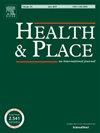俄克拉何马州塔尔萨和俄克拉何马州烟草零售商的分区划分和社会人口特征统计模式
IF 4.1
2区 医学
Q1 PUBLIC, ENVIRONMENTAL & OCCUPATIONAL HEALTH
引用次数: 0
摘要
居住在烟草零售商数量(即烟草零售商可得性)较多的社区与青少年和成人烟草使用行为有关。因此,减少TRA的政策已被确定为减少烟草使用和实现公平的烟草终局的重要干预措施。分区法规可以作为一种创新的政策工具加以利用,以减少烟草零售管理中的不公平现象,特别是在那些可能抢先获得地方烟草零售许可的州。本研究分析了2023年俄克拉荷马城和塔尔萨(美国俄克拉何马州)的区域划分和社会人口特征的TRA不平等。我们获得了俄克拉荷马州和塔尔萨所有许可烟草零售商的位置,并下载了包含所有分区名称的空间分区文件(例如,C-3,社区商业)。我们创建了2019-2023年美国社区调查人口普查区民族、种族和社会经济特征的五分之一。我们对这些数据进行了空间连接,并计算了分区指定范围内和所有人口普查区的烟草零售商总数。为了确定基于分区的不公平,我们拟合了线性回归模型,检验了人口普查区的社会人口五分位数与一个区域内每个分区指定的烟草零售商总数之间的关系。在这两个城市中,在黑人、西班牙裔或拉丁裔居民比例较高、白人居民比例较低、收入不平等程度较高、家庭收入中位数较低、生活在联邦贫困线以下的居民比例较高的社区,烟草零售商的数量普遍较高。在居民区附近有商业区的地区,生活在联邦贫困线以下的居民比例最高(与最低)的地区有1.4多家零售商(SE, 0.3, p <;0.001)。这种情况在塔尔萨也类似,但并不显著。相比之下,在白人居民比例最高(相对于最低)的地区,居住区附近有商业区划的地区的TRA较低(OKC: B = - 1.1;SE, 0.3, p <;0.01;塔尔萨:B =−3.0;SE, 0.8, p <;0.001)和最高(相对于最低)家庭收入中位数(OKC: B = - 1.4;SE, 0.3, p <;0.001;塔尔萨:B =−1.9;SE, 0.8, p <;0.05)。对于禁止实施以许可证为基础的减少TRA的政策的地方,分区法可能是减少TRA的唯一可行的政策办法,这也可能减少烟草使用方面的不平等,促进卫生公平。本文章由计算机程序翻译,如有差异,请以英文原文为准。
Patterns of tobacco retailer counts by zoning designations and sociodemographic characteristics in Oklahoma City and Tulsa, Oklahoma
Living in a neighborhood with a high count of tobacco retailers (i.e., tobacco retailer availability, TRA) is associated with youth and adult tobacco use behaviors. As such, policies that reduce TRA have been identified as an important intervention for reducing tobacco use and achieving an equitable tobacco endgame. Zoning regulations could be leveraged as an innovative policy tool to reduce inequities in TRA, especially in states that may preempt local tobacco retail licensing. This study analyzed TRA inequities by zoning designations and sociodemographic characteristics in Oklahoma City and Tulsa (Oklahoma, USA) in 2023. We obtained locations of all licensed tobacco retailers in OKC and Tulsa and downloaded spatial zoning files containing all zoning designations (e.g., C-3, Community Commercial). We created quintiles of 2019–2023 American Community Survey census tract ethnic, racial, and socioeconomic characteristics. We spatially joined these data and calculated the total count of tobacco retailers within zoning designations and across all census tracts. To identify zoning-based inequities, we fit linear regression models examining associations between sociodemographic quintiles of census tracts and the total count of tobacco retailers in each zoning designation in a tract. Across both cities, tobacco retailer counts were generally higher in neighborhoods with greater percentages of Black and Hispanic or Latine residents, lower percentages of White residents, higher income inequality, lower median household income, and higher percentages of residents living below the federal poverty line.
Among tracts with commercial zones near residential areas, tracts with the highest (vs. lowest) percentage of residents living below the federal poverty line had 1.4 more retailers (SE, 0.3, p < 0.001) in OKC. This pattern was similar in Tulsa though not significant. In contrast, TRA in tracts with commercial zoning near residential areas was lower in tracts with the highest (vs. lowest) percentage of White residents (OKC: B = −1.1; SE, 0.3, p < 0.01; Tulsa: B = −3.0; SE, 0.8, p < 0.001) and highest (vs. lowest) median household income (OKC: B = −1.4; SE, 0.3, p < 0.001; Tulsa: B = −1.9; SE, 0.8, p < 0.05). For places that are prohibited from implementing licensing-based policies to reduce TRA, zoning laws may be the only viable policy approach to reducing TRA, which may also reduce inequities in tobacco use, promoting health equity.
求助全文
通过发布文献求助,成功后即可免费获取论文全文。
去求助
来源期刊

Health & Place
PUBLIC, ENVIRONMENTAL & OCCUPATIONAL HEALTH-
CiteScore
7.70
自引率
6.20%
发文量
176
审稿时长
29 days
期刊介绍:
he journal is an interdisciplinary journal dedicated to the study of all aspects of health and health care in which place or location matters.
 求助内容:
求助内容: 应助结果提醒方式:
应助结果提醒方式:


